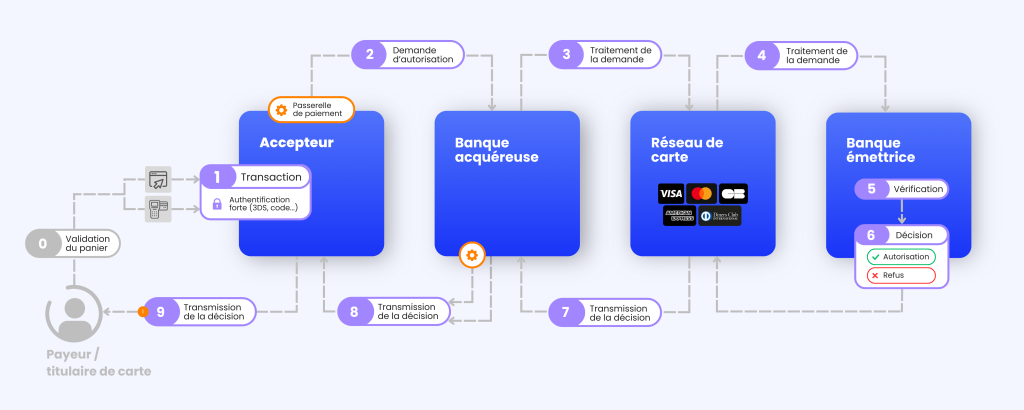Democratization of Card Payments
Before becoming the most widely used payment method in France, the bank card had come a long way. Inspired by the American model, the French card system developed in the 1960s. Twenty years later, chip cards appeared, flooding the French market, and gradually replacing the old magnetic cards.
Since then, card payments have continued to grow. The volume of card payments increased from 7.8 billion in 2012 to 16.1 billion in 2021, an increase of 110%². Covid-19 has further entrenched the bank card in European habits, since in 2020, it accounted for almost half of all financial transactions, all payment methods combined³.
This democratization of credit card payments is due in particular to the numerous government and European initiatives imposed on merchants to facilitate credit card payments:
- Reducing card transaction fees for merchants: A few years ago, a merchant could pay up to €0.10 in fees for a €5 transaction (depending on the contract established with their bank), leading them to refuse this payment method for small amounts. Today, for this same amount, a merchant will never pay more than €0.05.
- Widespread adoption of “contactless”: The implementation of “contactless” technology in French E-commerce sites began in 2015.
- Transaction security: To reassure the French about the adoption of new payment methods and effectively combat fraud, certain technical and regulatory compliance measures are required of merchants, such as PSD2 (strong authentication) or the Sapin 2 Law (know your customer – KYC), for example.
However, it is noted that the success of the bank card is at the expense of fiduciary means of payment, such as cash and checks.
The Evolution of Card Payments Since the 1970s
Cards in Traditional Retail
Over the decades, in-store payment has gone through many phases. The 1970s were marked by the dominance of bank checks, offering consumers an alternative to cash.
The introduction of bank cards and Electronic Payment Terminals (EPTs) in the 1980s truly revolutionized the dynamics of in-store transactions. Magnetic and then chip-enabled bank cards were widely adopted by the French, as they were perceived as the fastest and most secure payment method. Physical retail then saw the emergence of contactless card payments: +200% usage between 2012 and 2021⁴, half of physical transactions in 2023⁵.
Alongside the rise in bank card use in retail, many more modern and agile terminal offerings have emerged, facilitating the adoption of new payment technologies by merchants, strengthening transaction security, and improving operational efficiency.
The remote card payment revolution
On August 11, 1994, the first online transaction via a secure payment system took place. Breaking the boundaries of payment, it marked the beginning of a new era. Indeed, the 1990s saw the emergence of numerous e-commerce sites (eBay, Amazon) and other transfer services (PayPal), which profoundly changed the way we buy and pay online.
A few years later, with the advent of m-payment (mobile payment), remote payment options expanded further. Consumers can now pay by card, using a form received via email, SMS, WhatsApp, or QR code: “Pay by Link.” This option fully meets the demands of today’s connected consumers, whether they are professionals or individuals.
The recent digital transformation of physical points of sale marks the peak of this evolution, where the boundaries between online and offline commerce are blurring. Omnichannel now allows consumers to navigate seamlessly and seamlessly between sales channels, offering a unique consumer experience with numerous card payment options.
Alongside the arrival of players (particularly fintechs) supporting merchants in payment processing, new rules are emerging to ensure the security of all these online payment flows, whether in terms of anti-fraud (strong authentication) or bank card tokenization, for example.
How does a card payment work?
Behind a simple credit card payment, there are several players, types of flows, and specific jargon that must be mastered to understand the market.
The different players
The card payment ecosystem is complex and involves several players, including the main ones:
- Issuer/Issuing Bank: The financial institution, usually the bank, that manufactures and makes available debit and/or credit cards.
- Card Networks: The entity that provides the communication system used by card issuers and companies to process banking transactions. Some of the best-known networks include Visa, Mastercard, Carte Bancaire (CB), and American Express.
- Cardholder/Cardholder: The person who holds the bank card and whose name appears on it.
- Payer: The person who makes the payment using the card.
- Acquirer/Acquiring Bank: The merchant’s financial institution, usually the bank, that enables the acquisition, processing, and deposit of funds received by credit card, as well as the maintenance of its accounts.
- Acceptor: Any merchant or commercial entity that accepts card payments, in its own name or that of its network, whether physical or online.
- Beneficiary: The person who will receive the funds.
Other actors can intervene to streamline the processing of card payments, including:
- Payment Service Provider (PSP): The entity that provides services related to the acceptance of payments and processing of transactions, including merchant account management, transaction security, and regulatory compliance.
- Payment Orchestrator: The entity that coordinates and manages the entire payment process and processing, when a merchant uses multiple acquirers and PSPs, to facilitate transaction and authorization management.
- Payment gateway: The interface that connects the merchant website to the payment network and ensures the secure transmission of payment-related information between the merchant and the issuer (acceptance or refusal).
Card payment processing
A credit card transaction involves several steps, each performed by different parties:
- Transaction initiation: The payer (often the cardholder) initiates the transaction by entering their card details (on an online payment page or via a physical EFT) and authenticating themselves (code, 3DS, etc.).
- Sending an authorization request: The merchant (acceptor) receives this information. They send an authorization request to their acquiring bank via a payment gateway.
- Processing by the acquirer: The acquiring bank receives this request and forwards it to the relevant card network.
- Card Network Processing: The network receives the authorization request and redirects it to the cardholder’s issuing bank.
- Verification: The card issuer verifies the availability of funds, the validity of the card, and the absence of fraud warning signals.
- Autorisation ou refus : Suite à cette analyse, l’émetteur répond au réseau carte un « code de retour banque » afin d’autoriser ou de refuser la transaction.
- In the case of a refusal, an explanatory message will supplement the decision (insufficient funds, stolen card, limit reached, etc.).
- In the case of authorization, a capture is performed, meaning the funds are “blocked” until the next clearing, which will initiate the banking transaction to the acquiring bank.
- Transmission to Acquirer: The card network transmits the authorization or decline information to the acquirer.
- Transmission to Acceptor: The acquirer communicates this information to the merchant, either directly or via a payment gateway.
- Confirmation to Payer: The decision is transmitted to the payer via a merchant card receipt or electronic notification.
- Deposit of Funds: In the case of an authorized payment, the issuing bank transfers the funds to the acquiring bank, which then deposits them into the merchant’s account.
- Receipt by the beneficiary: If the beneficiary is not the merchant, but a designated third party, the merchant transfers these funds to the beneficiary.

Card-based payment services
The world of bank cards extends far beyond traditional transactions, thanks to a myriad of card payment options that meet the diverse needs of payers.
Some examples:
- Fast payment democratizes access to expensive goods, allowing consumers to spread the cost over several installments.
- Card subscription payments offer a seamless experience by automating the settlement of recurring transactions.
- Deferred payment allows users to postpone the start of their payment plan, for greater flexibility.
- Wallets allow consumers to pay from their phones via Apple or Google Pay.
- A bank imprint, as a secure payment method, verifies the validity and nature of the card for future payments.
- The one-click feature reduces steps, for faster checkout and an improved experience.
This diversification of services transforms card payments, facilitating recurring transactions and ensuring payment security, regardless of the channel, industry, or risk level.
Advantages and disadvantages of card payment
| Benefits | Disadvantages |
| Increased sales: Ideal for transactions up to €2,000, across all channels (online, in-store, remote) | Costs: More or less significant depending on the interchange (bank fees + card network fees) |
| Speed: Capture performed immediately, and funds transferred the next day | Caps: These can be higher or lower depending on the cardholder’s card type |
| Solvency: Authorization before debit, handled by the cardholder’s bank | Not suitable for B2B: Businesses primarily pay by bank transfer and not by credit card |
| Guaranteed: Even if the customer does not have the funds in his account, the merchant will be credited | |
| Low dispute rate: Strong authentication limits the risk of disputes and associated chargeback fees. | |
| Variety of payment options and methods: subscription, installment, one-click, deposit, deferred, etc. | |
| Customer experience: Simple, fully integrable, and universally familiar payment process. |
With 185 transactions per second in France, bank cards play a central role in our daily transactions, both in-store and online. It’s essential to integrate into your payment processes!
¹ Statista, Nombre de cartes bancaires françaises de 2012 à 2021 (2023)
² Statista, Analyse des opérations par cartes bancaires en France (2023)
³ BCE (2020)
⁴ Statista, Paiements sans contact en France (2023)
⁵ Insee & BPCE (2023)




